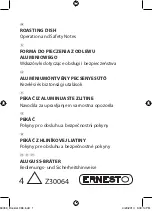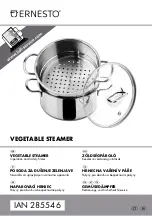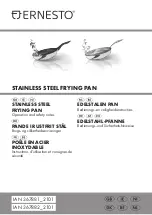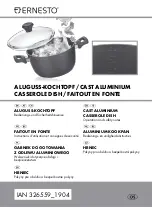
11
Cooking techniques
Stir frying
Recommended Temperature Control Probe setting
‘High Sear’.
•
An energy efficient and healthy way of cooking
foods. The benefit of this method is its speed and
flavour result. The cooking action for stir frying is a
continual tossing motion to ensure the food is
evenly exposed to the heat and cooks quickly and
evenly in a couple of minutes.
•
Stir frying should be carried out using a ‘High
Sear’ setting.
•
Preheat your frypan before adding any ingredients,
allowing the heating light to cycle ‘On’ and ‘Off’
several times. This will allow the frypan to reach
and maintain an even high temperature.
•
Stir frying is a dry heat cooking method and is best
suited to tender cuts of meat. Timing is a key factor
as over cooking will give a tough, dry result.
Cooking times will depend on the size and
thickness of the meat, as the bigger the pieces, the
more time needed.
Recommended cuts
Beef
Lean beef strips prepared from rump,
sirloin, rib eye, fillet.
Chicken
Lean chicken strips prepared from breast
fillets, tenderloins, thigh fillets.
Lamb
Lean lamb strips prepared from fillet, lamb
leg steaks, round or topside mini roasts,
eye of loin.
Pork
Lean pork strips prepared from leg,
butterfly or medallion steaks or fillet.
Veal
Eye of loin, fillet, round, rump or topside.
Stir fry tips
•
Prepare meat strips from recommended cuts as listed
above by removing fat and slicing thinly across the
grain (across direction of meat fibres). Slicing across
the grain ensures tenderness. Cut into very thin strips,
approximately 5-8cm in length. Partially freeze meat
(approximately 30 minutes) to make slicing easier.
• Buy meat strips already prepared from your butcher
or supermarket.
•
Stir fry meat strips in small batches (approx 200-300g)
to keep juice in meat and avoid ‘stewing’, resulting in
tougher meat.
•
Meat strips should sizzle when added to the frypan.
•
Stir fry meat strips for 1-2 minutes. Longer cooking
will toughen meat.
•
Remove each batch when cooked and allow frypan
to reheat before stir frying the next batch. By
cooking in small batches the heat of the frypan
remains constant, ensuring the meat doesn't stew
and toughen.
•
A small amount of oil can be mixed through the
meat strips before adding to the frypan, along any
other flavouring such as garlic, ginger and chilli.
A little sesame oil can also add flavour. Mixing the
oil with the meat in this way cuts down on the
quantity used.
•
Drain off thin marinades from meat strips before
stir frying to prevent stewing and splatter.
•
Stir fry vegetables in a little oil (or sprinkling
of water) before meat is added for vivid colour and
crispness.
10
Cooking time
Ingredient
3 minutes
Onion, quartered,
Broccoli, flowerets
Carrots, sliced
Soaked Chinese dried mushrooms
2 minutes
Snow peas
Capsicum, sliced
Zucchinis, sliced
Water chestnuts
Bamboo shoots
1 minute
Garlic, minced
Chilli, minced
Ginger, minced
Shallots, chopped
Bean sprouts
Suggested times for stir-frying vegetables:
These brief cooking times will keep vegetables crisp.
•
Peanut oil is traditionally used for stir fry Asian
style dishes. However other oils such as vegetable,
canola and light olive may be used.
•
Do not over fill the frypan. If necessary, cook in
batches and reheat at the end of stir frying. If using
this method remember to under cook slightly so
reheating will not spoil the finished dish.
•
Serve stir fried foods immediately to retain their
crisp texture.
Sautéing
Recommended Temperature Control Probe setting 12-14.
Use for sautéing onions, garlic, spices, pastes, herbs,
vegetables, meat and seafood.
If using oil to sauté, use setting 14. If using
butter, use setting 12.
That’s the idea
™






































